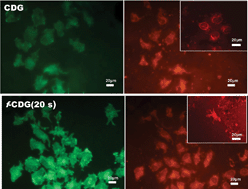Reduction in oxidative stress during cellular responses to chemically functionalised graphene†
Abstract
The two-dimensional nanocarbon material graphene (Gr) has been extensively studied due to its many potential biomedical applications including regenerative medicine, drug delivery, bioimaging, and biosensing. The effects of nitrogen-functionalisation on chemically driven Gr (CDG) cellular responses were studied by investigating the generation of reactive oxygen species (ROS) and mitochondrial morphology as well as focal adhesion, shape, proliferation and viability of HeLa cells grown on functionalised CDG (f-CDG) films. The drop casting of CDG nanosheets formed thin CDG films and the formation of nitrogen groups on the f-CDG thin films was mediated by N2 plasma treatment without the formation of observable surface defects. N-containing functional groups on the CDG thin films contributed to an increase in hydrophilicity. The proliferation and viability of HeLa cells grown on the f-CDG thin films were enhanced compared to those grown on CDG films alone and control samples. N-functionalisation of CDG thin films effectively reduced the ROS generated from cells on the f-CDG films. These results indicate that N2 plasma treatment of CDG is very useful in improving biocompatibility for the bio-application of graphene materials.


 Please wait while we load your content...
Please wait while we load your content...